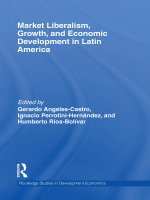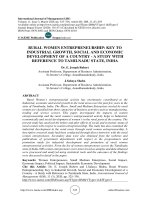Economic growth and economic development 400
Bạn đang xem bản rút gọn của tài liệu. Xem và tải ngay bản đầy đủ của tài liệu tại đây (90.77 KB, 1 trang )
Introduction to Modern Economic Growth
ratio and consumption per capita change with the underlying parameters. For this
reason, let us again parameterize the production function as follows
f (k) = af˜ (k) ,
where a > 0, so that a is again a shift parameter, with greater values corresponding
to greater productivity of factors. Since f (k) satisfies the regularity conditions
imposed above, so does f˜ (k).
Proposition 8.3. Consider the neoclassical growth model described above, with
Assumptions 1, 2, 3 and 4’, and suppose that f (k) = af˜ (k). Denote the steadystate level of the capital-labor ratio by k∗ (a, ρ, n, δ) and the steady-state level of
consumption per capita by c∗ (a, ρ, n, δ) when the underlying parameters are a, ρ, n
and δ. Then we have
∂k∗ (a, ρ, n, δ)
∂k∗ (a, ρ, n, δ)
∂k∗ (a, ρ, n, δ)
∂k∗ (a, ρ, n, δ)
> 0,
< 0,
= 0 and
<0
∂a
∂ρ
∂n
∂δ
∂c∗ (a, ρ, n, δ)
∂c∗ (a, ρ, n, δ)
∂c∗ (a, ρ, n, δ)
∂c∗ (a, ρ, n, δ)
> 0,
< 0,
< 0 and
< 0.
a
n
Proof. See Exercise 8.5.
Ô
The new results here relative to the basic Solow model concern the comparative
statics with respect the discount factor. In particular, instead of the saving rate, it
is now the discount factor that affects the rate of capital accumulation. There is a
close link between the discount rate in the neoclassical growth model and the saving
rate in the Solow model. Loosely speaking, a lower discount rate implies greater
patience and thus greater savings. In the model without technological progress, the
steady-state saving rate can be computed as
δk∗
.
(8.23)
s∗ =
f (k∗ )
Exercise 8.7 looks at the relationship between the discount rate, the saving rate and
the steady-state per capita consumption level.
Another interesting result is that the rate of population growth has no impact on
the steady state capital-labor ratio, which contrasts with the basic Solow model. We
will see in Exercise 8.4 that this result depends on the way in which intertemporal
discounting takes place. Another important result, which is more general, is that k∗
386









